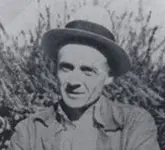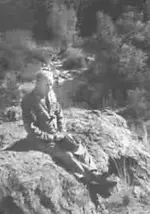Sunday April 20, 1980 Arizona Republic
A Pioneer's search for the Lost Dutchman Mine ends at 88.
Nyle Laetham was a long time professional photographer and was friends with George “Brownie” Holmes, a famous seeker of the Lost Dutchman Mine. When Holmes died in 1980 Laetham wrote a tribute to his old friend and it was printed in the Arizona Republic newspaper. Here is that tribute as it appeared some 41 years ago.
George "Brownie" Holmes died April 11, 1980 in his Phoenix home on the morning of his 88th birthday. Brownie Holmes may well have been the last of his kind, one of the pioneer seekers of the Lost Dutchman Mine at the turn of the century after the death of old Jacob Waltz himself.
Brownie wrote no books, published no maps, and avoided interviews and arguments. He relished the thought that most Lost Dutchman hunters never heard of him. That way, they did not hinder his own search. Brownie believed his father (Dick Holmes) account of what Jacob Waltz said on his deathbed and spent most of his lifetime in happy pursuit of the golden dream.
This is his story, more complete than he ever allowed it to be told in his lifetime.
Born in Phoenix in 1892, Brownie Holmes was, by his own understatement, "almost a pioneer." His grandfather, R.J. Holmes Sr., arrived at the site of Fort Yuma in 1847, having traveled from Holmes County, Miss. Brownie's father, R.J. "Dick" Holmes, was born at old Fort Whipple in 1865. He ranched in Bloody Basin, where Holmes Creek and Holmes Canyon are named for him. He also worked as a packer for the Army out of Fort McDowell for the famous Al Sieber.
A chance event on the streets of Phoenix in October 1891 altered the lives of the Holmes family for the next two generations. A German-immigrant prospector named Jacob Waltz, known locally as "the Dutchman," lay dying in the home of Julia Thomas on Jackson Street.
As Mrs. Thomas went for a doctor, she met Dick Holmes and Gideon Roberts, whom she asked to watch over the Dutchman during her absence. It was to Holmes and Roberts that the Dutchman made his deathbed revelation that he secretly was working an incredibly rich, hidden gold mine in the Superstition Mountains. His story appeared substantiated by nearly 50 pounds of high-grade gold ore in a miner's candle box under his bed.
Grubstaked with gold from the dying Dutchman, the two men began to search for the mine. Roberts died shortly thereafter, and Holmes hunted on alone. In 1908, unable to search any longer, Holmes took his young son, Brownie, to the Superstitions to familiarize him with the landmarks he had discovered.
George “Brownie” Holmes, aged 16, packed into the mountain wilderness, intending to devote four months to searching for the mine. His search lasted 40 more years. To finance his efforts, yet still be close to the Superstitions, he took a job driving a passenger stage for Wes Hill Stage Lines over the Roosevelt Road, later known as the Apache Trail. His record with the stage line was marred only by his using a company vehicle to participate in the lynching of murderer Star Daley, an indiscretion for which he received a tongue-in-cheek suspension of 24 hours.
In 1910, he met William Augustus "Tex" Barkley, whose cattle-ranching operations encompassed the Superstition Mountains area. A relationship that was to extend over both their lifetimes was established. Brownie’s search for the Lost Dutchman Mine also continued under this arrangement during the years the Quarter Circle was operated by Tex Barkley's son, Bill Barkley. Brownie Holmes rode 35 roundups for the Barkley Cattle Company. During those years, he became well-known among early residents of the Apache Junction area.
His search was interrupted by World War I. Brownie enlisted in the Army, serving with the artillery in France. A lifelong humorist and an incurable prankster, he put his cowboy skills to practice while stationed in France and kept his unit well-fed by cruising the French countryside, roping domestic geese from the sidecar of a motorcycle. "My military distinction, I'm afraid, consisted of becoming the world's champion goose roper," he later recounted.
After the war, he entered into an agreement with Tex Barkley. Ostensibly employed as a cowboy on Berkley's Quarter Circle U Ranch, Holmes did in fact spend much of his time attending to the affairs of the ranch. But always, with Barkley's encouragement, he was given free rein to work those areas in which he felt the mine was hidden.
Injured when a horse fell on him in 1948, Brownie was obligated to leave the Superstitions. While convalescing in Phoenix in 1950, he met and married Thelma Neff. They had a daughter, Georgie, since deceased. Brownie later worked until retirement as a packer for the Arizona Game and Fish Department.
Brownie Holmes placed no small value on the knowledge he possessed and evaded any discussion beyond mere generalities. Brownie's reluctance to talk about the Lost Dutchman Mine generated some bitterness. Both Brownie and his father were sometimes publicly maligned; it was even claimed that the Holmes family was not in Arizona during the Dutchman's lifetime, an accusation easily countered by records of the 1865 First Territorial Church.
Only mildly discouraged by his inability to locate the mine, Brownie Holmes to his death remained convinced of its existence. His last years were spent quietly at home in Phoenix, his hopes sustained by the efforts of a younger friend who continued the search on his behalf. Brownie Holmes' quest ended on April 11, when he died quietly in his sleep. He requested no services be held and that after cremation his ashes be scattered in the Superstition Mountains.
Early one morning last week, a lone rider saddled up at the trailhead at First Water, loaded a pack horse, and rode eastward, headed for a secluded grassy knoll in a canyon hidden deep in the Superstitions. Brownie Holmes was being taken home.
The legend of the Lost Dutchman Mine never ceased to dominate the life of George Brownie Holmes. Because of the universal appeal of the Lost Dutchman story, Brownie was eagerly sought by many who wanted to search for the gold or write about it. To him, however, his knowledge of the mine and the clues represented two generations of effort and in the end he parted with that knowledge only to his closest friend.






